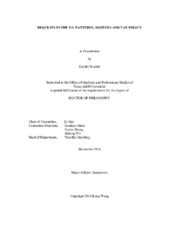| dc.contributor.advisor | Gan, Li | |
| dc.creator | Wang, Kang | |
| dc.date.accessioned | 2017-02-02T16:42:38Z | |
| dc.date.available | 2017-02-02T16:42:38Z | |
| dc.date.created | 2016-12 | |
| dc.date.issued | 2016-12-07 | |
| dc.date.submitted | December 2016 | |
| dc.identifier.uri | https://hdl.handle.net/1969.1/158709 | |
| dc.description.abstract | This dissertation studies three topics on bequests and bequest motives. It firstly documents the patterns and time trends of bequest distributions. Then this dissertation estimates the impacts of bequests and estate taxation on the income distribution of children. Thirdly this dissertation provides new evidence on a positive relationship between children and bequest motives and reconciles the new findings with different the mixed evidence in literature.
On the distributions of bequests over time, this dissertation finds that bequests in aggregate are between 300 and 700 billions of 2012 dollars. Housing and financial assets dominant other bequeathable assets and account for over 60 percent of all bequests. Moreover, bequests are highly concentrated on the rich few that the top 10 percent decedents contribute over 60 percent of all bequests during 16 years. Finally, surviving spouses inherit almost all bequests of decedents and children inherit about 77 percent of all bequests if the decedents are single.
Despite the significant aggregate scale of bequests and the nontrivial average annual income generated by inheritances, the impacts of receiving bequests and imposing estate taxes are trivial—no more than 3 percent—on the income inequality of children. The reason is that the annual income from inheritance is too small that account for only about 3 percent of the total income of children and their households on average.
Last but not least, this dissertation finds that the opposite effects of the parents’ belief of future help from children and the excessive financial burdens of some parents on bequest motives and actual bequests lead to negative findings on the relationship between having a child and having a bequest motive in literature. Finally this dissertation reconciles the new evidence with the mixed evidence of bequest motives in literature. | en |
| dc.format.mimetype | application/pdf | |
| dc.language.iso | en | |
| dc.subject | Bequest distribution | en |
| dc.subject | estate tax | en |
| dc.subject | income inequality | en |
| dc.subject | parent-child interactions | en |
| dc.subject | excessive financial burdens | en |
| dc.title | Bequests in the US: Patterns, Motives, and Tax Policy | en |
| dc.type | Thesis | en |
| thesis.degree.department | Economics | en |
| thesis.degree.discipline | Economics | en |
| thesis.degree.grantor | Texas A & M University | en |
| thesis.degree.name | Doctor of Philosophy | en |
| thesis.degree.level | Doctoral | en |
| dc.contributor.committeeMember | Meer, Jonathan | |
| dc.contributor.committeeMember | Zhang, Yuzhe | |
| dc.contributor.committeeMember | Wu, Ximing | |
| dc.type.material | text | en |
| dc.date.updated | 2017-02-02T16:42:38Z | |
| local.etdauthor.orcid | 0000-0002-6396-0709 | |


